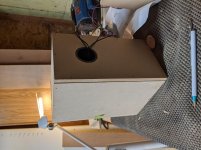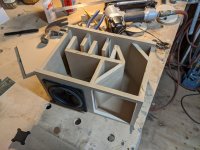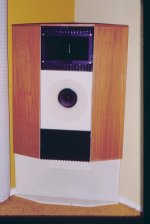OK. So I've been interested in making a full range speaker for a long time now and have always been fascinated by the ones with the meandering, almost intestinal-like channel design.
As a little experiment I made two identical cabinets (see attached images). The first is a standard box with a plastic tube as a bass port and the other with the weaving channel design, both using MDF.
I expected the one with the meandering channel to sound better since that's what I see people building, and it's certainly more complicated than a simple box with a tube in it, but some how the traditional design sounds louder, fuller and bassy-er.
Why is that? What am I doing wrong?
As a little experiment I made two identical cabinets (see attached images). The first is a standard box with a plastic tube as a bass port and the other with the weaving channel design, both using MDF.
I expected the one with the meandering channel to sound better since that's what I see people building, and it's certainly more complicated than a simple box with a tube in it, but some how the traditional design sounds louder, fuller and bassy-er.
Why is that? What am I doing wrong?
Attachments
The 2nd is a poor attemp at designing a horn. There are “rules” as to the nature of the "meander." To get anywhere near the same bass extension it would need to be much larger. The limit of the LF can be estimated as the same frequency that has the same length waveform as the circumference of the mouth. Below that it is an undamped, poorly designed, transmission line — no damping means lots of ringing.
And when you do your final build, use quality plywood.
dave
And when you do your final build, use quality plywood.
dave
It's very much as planet10 has said. I admire your willingness to just build something though, I could do with some of that 🙂
What full range driver is that? Maybe somebody has already modelled it's response in a few different but appropriate enclosures?
What full range driver is that? Maybe somebody has already modelled it's response in a few different but appropriate enclosures?
Have you tried equalising the responses and listening for differences, just to eliminate that as a factor?
The compromise between the two that does improve the quality of the reflex [vented] is a constant taper, offset driver, vented TL [aka MLTL] or if you prefer, horn tapered variant [aka ML-horn or ML-TQWT or ML-Voigt].
In the meantime, experiment with venting your BLH to see if you can get an overall better performing reflex.
In the meantime, experiment with venting your BLH to see if you can get an overall better performing reflex.
What full range driver is that?
The driver is a Dayton Audio DMA105-8. I just got this because I didn't want to pay a lot for just experimenting.
The 2nd is a poor attemp at designing a horn. There are “rules” as to the nature of the "meander." To get anywhere near the same bass extension it would need to be much larger. The limit of the LF can be estimated as the same frequency that has the same length waveform as the circumference of the mouth. Below that it is an undamped, poorly designed, transmission line — no damping means lots of ringing.
And when you do your final build, use quality plywood.
dave
Do you have any good resources for the rules for designing horns? I can also do CAD so is there is a software simulation tool for this stuff?
Dayton Audio DMA105-8
Might work in a big TL or horn I could not find a decent BR alignment, the Qts is too high.
I’d use a 15 litre sealed box.
dave
This is an old school design summary that gives a good footing in the basics.
http://p10hifi.net/planet10/TLS/downloads/Dinsdale-Horns-3parts.pdf
From there you then use tools like the MJK worksheets, HornResp, or the Transmisison Line simulator to model it.
dave
http://p10hifi.net/planet10/TLS/downloads/Dinsdale-Horns-3parts.pdf
From there you then use tools like the MJK worksheets, HornResp, or the Transmisison Line simulator to model it.
dave
I can also do CAD so is there is a software simulation tool for this stuff?
I've never seen one. It would be quite complex.
jeff
A tool that simulates and generates a CAD drawing… i have one in my head, but it would still export basic CAD files to a real CAD program for the detail bits.
Take a whack of investment to get off the ground.
dave
Take a whack of investment to get off the ground.
dave
Indeed! The MathCad math design routine MJK originally published had some incredibly complex formulas to my math challenged mind.
Dave, for anyone interested in pursuing it, I got a 404 error on that URLThis is an old school design summary that gives a good footing in the basics.
404 Error - Page Not Found
From there you then use tools like the MJK worksheets, HornResp, or the Transmisison Line simulator to model it.
dave
Yeah, if the maths for speaker enclosure design were simple, almost any fool would be trying it.
Oh, wait, what? 😉
Last edited:
Sorry. My bad. I had the whole article and just part 3 on the server and cleaning up tossed the wrong file. Fixed now.
dave
dave
Ancient Dinsdale corner horn
Seeing your post of the Dinsdale articles, they got me interested when they came out. I built the corner horn on my kitchen table, using a cheap Eagle 6.5" FR unit. I sent a photo to Dinsdale and he replied that it proved they could be made. A picture appeared in the Wireless World annual with the reprint of the articles. The pic shows the plaster horn which I devised a method of making entirely without machinery. Also shown is the later experiment of a Decca ribbon HF unit.
Bringing us up to present day I have just made a large cabinet for the Hemp Acoustics FR8 which has re-ignited interest in FR speakers (posted in the FR photo thread). Now I will be asking advice on a Mark Audio/Frugal horn for the small den I listen in.
Seeing your post of the Dinsdale articles, they got me interested when they came out. I built the corner horn on my kitchen table, using a cheap Eagle 6.5" FR unit. I sent a photo to Dinsdale and he replied that it proved they could be made. A picture appeared in the Wireless World annual with the reprint of the articles. The pic shows the plaster horn which I devised a method of making entirely without machinery. Also shown is the later experiment of a Decca ribbon HF unit.
Bringing us up to present day I have just made a large cabinet for the Hemp Acoustics FR8 which has re-ignited interest in FR speakers (posted in the FR photo thread). Now I will be asking advice on a Mark Audio/Frugal horn for the small den I listen in.
Attachments
Last edited:
Superb.
I do not know how many times i revisted that design, even trying to implement the ideas in my PA horns.
I really like the Decca ribbons. I had some Londons that still stand out in my mind. Make for a superb Econowave.
What box did you put the FR8 into? I only ever heard the 4.5”. Hemp Acoustics had huge promise, to bad Pecker was a crook.
dave
I do not know how many times i revisted that design, even trying to implement the ideas in my PA horns.
I really like the Decca ribbons. I had some Londons that still stand out in my mind. Make for a superb Econowave.
What box did you put the FR8 into? I only ever heard the 4.5”. Hemp Acoustics had huge promise, to bad Pecker was a crook.
dave
This is the Apre Grande which I made a few inches shorter but with slightly wider internal dimension to keep the same vol. I never got round to making it for a decade and wish I had!
https://www.diyaudio.com/forums/full-range/65061-range-speaker-photo-gallery-464.html#post6594916
My little den is a narrow room 8 ft by 15ft long. The drive unit centres are 6ft apart. They actually work quite well in that position with a rich midrange and don't excite room too much. I have added a small inductor in parallel with a 8ohm resistor. However I think they too easily overdrive the room and am wondering if a smaller model would be advisable. Should I start a new thread?
https://www.diyaudio.com/forums/full-range/65061-range-speaker-photo-gallery-464.html#post6594916
My little den is a narrow room 8 ft by 15ft long. The drive unit centres are 6ft apart. They actually work quite well in that position with a rich midrange and don't excite room too much. I have added a small inductor in parallel with a 8ohm resistor. However I think they too easily overdrive the room and am wondering if a smaller model would be advisable. Should I start a new thread?
- Home
- Loudspeakers
- Full Range
- Speaker Design Advice?


